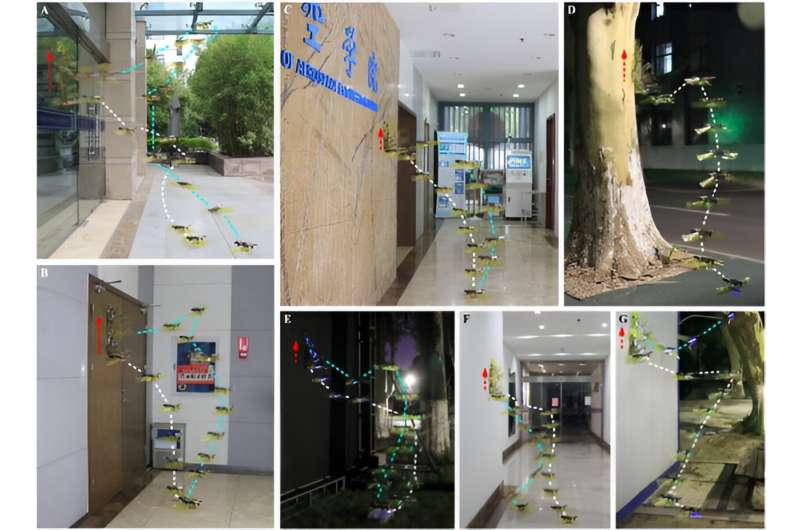This article has been reviewed according to Science X's editorial process and policies. Editors have highlighted the following attributes while ensuring the content's credibility:
fact-checked
proofread
New design lets robotic insect land on walls and take off from them with ease

Insects in nature possess amazing flying skills and can attach to and climb on walls of various materials. Insects that can perform flapping-wing flight, climb on a wall, and switch smoothly between the two locomotion regimes provide us with excellent biomimetic models. However, very few biomimetic robots can perform complex locomotion tasks that combine the two abilities of climbing and flying.
It is challenging to design both the flying and climbing power systems with characteristics similar to an insect's flapping wings and wall-climbing skills. Flying-climbing transition control strategy is difficult to apply to bionic flying-climbing robots.
This is mainly because current flapping wing flight systems that can hover find it difficult to generate enough lift to support the wall-climbing robot as a load, and study of wall-climbing robots that can attach to various types of surfaces is not comprehensive.
In addition, the wall-oriented flying-climbing transition control method still needs to be studied in order to design the movement mode that can effectively mimic natural insects landing on and taking off from the wall.
Recently, a team of Nanjing University of Aeronautics & Astronautics (NUAA) has developed a new attitude transition control strategy. A bionic robot with flying and climbing ability can complete smooth movement including landing on a vertical wall, climbing along the wall, and taking off from the wall.
"The robot with cross-domain movement ability can expand the space of a single-domain robot, and solve the problems that a single-domain robot faces, such as limited application and difficulty interacting with external physical quantities," said Aihong Ji, who led the research.
The aerial–wall robot has successfully demonstrated its ability to land, climb, and take off from a variety of complex vertical walls, including glass, wooden door, marble, tree bark, elastic cloth, lime Wall, and painted iron sheet. This series of steps is very common in nature, for instance, when a fly arrives at a location after flying some distance, lands on a wall, climbs to a place where it feels comfortable, and then flies to the next place. It has important implications in understanding the takeoff and landing of insects.
The study was published in Research. Ji is a professor in NUAA's College of Mechanical and Electrical Engineering.
The robot insect adopts a flapping/rotor hybrid power layout, which realizes not only efficient and controllable flight in the air but also attachment to, and climbing on, the vertical wall through a synergistic combination of the aerodynamic negative pressure adsorption of the rotor power and a climbing mechanism with bionic adhesion performance.
"Insects can both fly in the air and climb on the wall, which benefit by their agile control of flapping wing and body posture. They use wing, leg, and visual information to coordinate takeoff and landing," Ji said. "The lift generated by the flapping wings is upward as the insect is hovering, while the body posture can be arbitrarily changed. Especially when landing on a wall or taking off from a wall, it is necessary to complete a series of complex modular actions, including body deceleration and large angle rotation of the body. We were inspired to realize that a bionic amphibious robot with large-angle-rotating ability is expected to complete the transition between flying and climbing by imitating insect's control of body posture."
But in contrast to the layout of the insect's climbing legs relative to its body, the climbing part is designed above the robot body, Ji noted. So the power of the flying part of the robot can not only provide aerodynamic negative pressure adsorption for the climbing part, but also resist the overturning moment caused by gravity.
The longitudinal axis layout design of the rotor dynamics and control strategy realize a unique cross-domain movement during the flying–climbing transition. The robot insect provides sufficient control force and torque. The net vertical thrust of the flapping/rotor hybrid power when actuated maintains an approximately linear relationship with respect to the throttle command. Moreover, under the composite control signal, the 3-axis torque input and output of the flapping/rotor hybrid power control were proven to be independent and non-interfering. The torque value meets the control demand and the control distribution logic is reasonable.
"In order to optimize the flying-climbing transition scheme of bionic amphibious robot, we have conducted several pretests," Ji said. "The flying-climbing transition process is closely dependent on the hybrid layout design and requires coordinated control of the actuators."
The team quantified the transition performance of the robot insect. The robot can perform continuous and complete air–wall–air transitions in 6.1 s. It enables the robot to cross the air–wall boundary in 0.4 s (landing), and cross the wall–air boundary in 0.7 s (taking off). The climbing speed on the vertical wall is 6 cm/s. It demonstrated the ability of the aerial–wall robot to transition between flying in the air and climbing on the wall and verified the feasibility of the overall structure layout and the control strategy.
Ji imagines that microscopic hooks and claws will be added in the injection mold of the adhesive pad to truly achieve the synergistic interaction between the hooks and adhesive pads of insects, which will help them adapt to complicated environments.
More information: Qian Li et al, An Aerial–Wall Robotic Insect That Can Land, Climb, and Take Off from Vertical Surfaces, Research (2023). DOI: 10.34133/research.0144



















